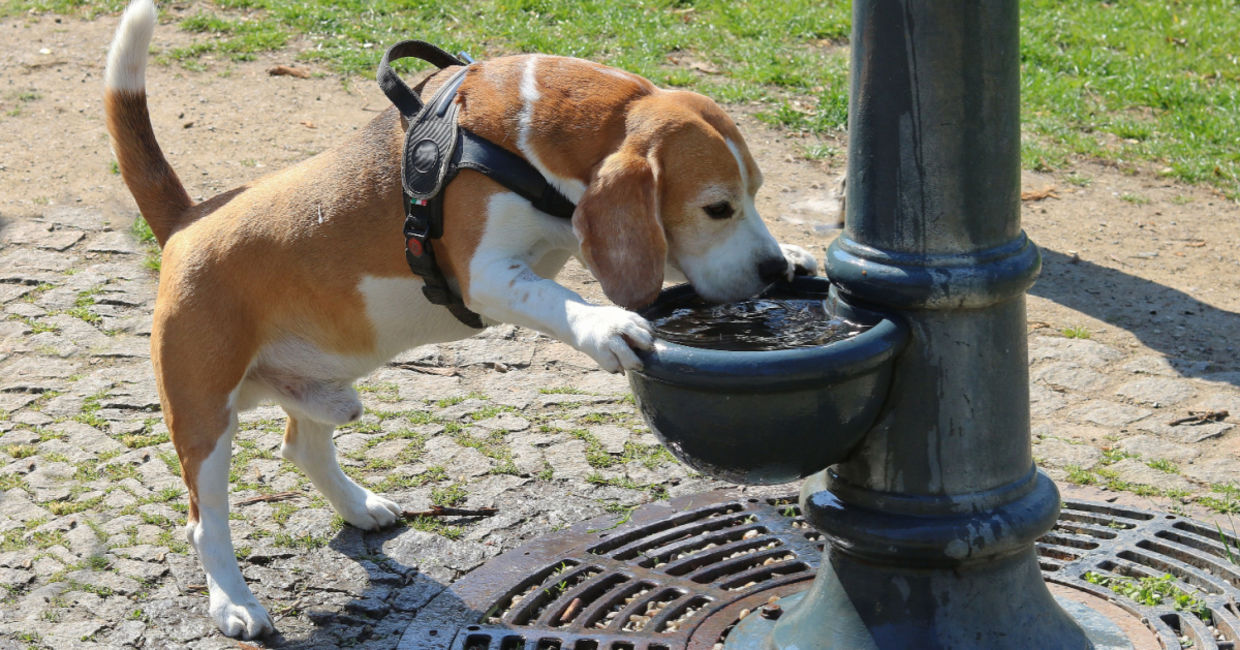
(Vltava / Shutterstock.com)
The summer heat means that people should stay cool and hydrated. But did you know that your pets need the same kind of heat protection? If you feel hot, so do your pets.
Now, with record-breaking heat waves, your pets need even more protection, according to National Geographic. Dogs, cats, and other pets all experience and show symptoms of overheating differently than people do. That’s why it is essential that you understand how heat affects your pets.
“Pet owners sometimes judge heat by how they feel, and that’s not what we need to do,” Barbara Hodges, a veterinarian and director of advocacy and outreach for the Humane Society Veterinary Medicine Association told National Geographic.
One example is that people don’t realize how hot asphalt can be because they wear shoes. “You drive somewhere [with your dog] and think, Oh, I’ll just run across the parking lot into the clinic, not realizing that it would really hurt if you don’t have shoes on, ” Hodges said.
Animals do not cool down the same way as people do. Dogs and cats sweat through their paws and noses. A dog will pant to cool down and cats will groom their fur to stay cool. But this applies to normal summer temperatures.
Extreme heat can actually overwhelm animal’s thermoregulation so that they are unable to shed the excess heat. This can lead to heatstroke that can be fatal. Some pets like pugs and bulldogs, are more susceptible to heat stroke, according to The LA Times. Young pups and senior ones are also more susceptible to heat issues.
Small animals like rabbits and guinea pigs are also very susceptible to heat. “If you have a rabbit, chinchilla or guinea pig … they are very sensitive to the heat and they can die inside the house if it gets to be 85 or 90 [degrees] and there’s no movement of air,” veterinarian and animal hospital owner Dr Clyde Pitts told The LA Times.
While heatstroke can happen anywhere, being alert and knowing how to care for your pets will ensure their comfort and safety. Here are five tips to caring for your pets in the heat.
Don’t leave your pet in a parked car
While you may think that leaving a window open will provide air, it is not enough. If you are running errands on a hot day, leave your pets home because temperatures in a parked car can quickly rise to a dangerous level.
“It’s just not worth the risk to their health and safety,” Jennifer Hawkins, a veterinarian who is the executive director for the Southern California Veterinary Medical Association said. “It can only take a few moments with mild weather outside for the car to reach unbearable temperatures, much less the heat that we’re experiencing right now.”
Limit exercising in the heat
You should limit outdoor activities like long walks and playing at the dog park to cooler times of the day. Remember to stop frequently and give your dogs a rest in the shade. The RSPCA recommends using pet-safe sunscreen on exposed areas of your pets skin. When you return home, give your pet a damp towel to help them cool down faster.
Keep hydrated
Your pets should also stay hydrated on hot days so let them drink before you leave and take some water along with you. You can bring a travel bowl with you on walks, suggested The LA Times. If you have an outdoor pet, make sure that you have multiple spill-proof bowls. It’s hot out there.
Stay in the shade
Whether your pets are indoor or out, its important to stay in the shade. Caged animals should be kept out of direct sunlight. You can put a frozen water bottle in the cage to keep your pets cool.
“Keeping your pets cool — aside from your energy bill — should be relatively inexpensive,” Hawkins told the LA Times. “There’s a lot of great novel products like cooling beds, but they’re not required. A simple fan [and] using the shade are great ways to keep pets comfortable.”
Watch for heatstroke
Your pet’s temperature can soar in the heat. Common signs of heatstroke include excessive panting, drooling, vomiting , diarrhea, and lethargy. Some pets can collapse or go into a seizure. If your pet shows any signs of heatstroke, contact your veterinarian. For emergency first aid, move your pet to a cool area and apply tepid water on the areas of his or her body that has less fur, like the belly, armpits, and paws.
YOU MIGHT ALSO LIKE:
How to Keep Pets Warm in Cold Weather
Food Pantries Open to Feed Hungry Pets
7 Dog-Friendly Vacation Spots to Explore







